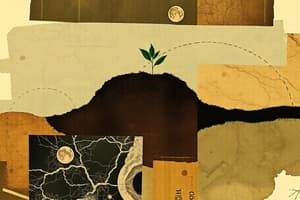Podcast
Questions and Answers
What is the composition of loam soil?
What is the composition of loam soil?
- Mainly silt particles
- Mainly sand particles
- A mix of sand, silt, and clay particles (correct)
- Primarily clay particles
Which type of soil drains well and is often used in landscaping?
Which type of soil drains well and is often used in landscaping?
- Loam soil
- Clay soil
- Peat soil
- Sand soil (correct)
What characteristic makes sand soil suitable for growing specific plants that require well-drained soils?
What characteristic makes sand soil suitable for growing specific plants that require well-drained soils?
- Compacted structure
- High nutrient content
- High organic matter content
- Large particle size and good drainage (correct)
How many general categories are soils typically classified into?
How many general categories are soils typically classified into?
What does soil quality reflect?
What does soil quality reflect?
Which property influences soil quality by affecting its ability to sustain biological productivity?
Which property influences soil quality by affecting its ability to sustain biological productivity?
What does soil fertility refer to?
What does soil fertility refer to?
Which factor does NOT influence soil fertility?
Which factor does NOT influence soil fertility?
How has agricultural expansion impacted soil?
How has agricultural expansion impacted soil?
What is an essential role of soil scientists and researchers?
What is an essential role of soil scientists and researchers?
Which activity is NOT conducted by soil scientists and researchers?
Which activity is NOT conducted by soil scientists and researchers?
How have historic landscape changes affected soil erosion?
How have historic landscape changes affected soil erosion?
Flashcards are hidden until you start studying
Study Notes
Exploring Soil Resources: Types and Impact
Soil is a complex, dynamic natural resource that serves as the foundation for global agriculture, ecosystems, and human development. Understanding the diversity of soil and its resources is crucial for managing our planet's resources and supporting sustainable practices.
Soil Types
Soils have varying textures, colors, and structures, determined by their composition, parent material, and environmental factors. For example, loam is a well-balanced mix of sand, silt, and clay particles, providing favorable conditions for plant growth. In contrast, sand is composed of large particles, drains well, and is often used in landscaping or for growing specific plants that require well-drained soils.
Soils are typically classified into six general categories: sand, loam, silt, clay, peat, and organic soils. Each type offers unique characteristics that influence agricultural productivity, ecosystem function, and human development.
Soil Resources
Soil resources encompass soil quality, fertility, and the ecosystem services they provide.
Soil Quality
Soil quality reflects a soil's ability to sustain biological productivity, maintain environmental quality, and support human health and well-being. It is influenced by soil's physical, chemical, and biological properties like texture, structure, nutrient content, and organic matter content.
Soil Fertility
Soil fertility refers to a soil's ability to supply the necessary nutrients and water required for plant growth. Soils with high fertility promote healthy, productive vegetation and are essential for food production. Factors that influence soil fertility include organic matter content, soil pH, and the presence of essential nutrients.
Ecosystem Services
Soils provide several ecosystem services, such as supporting plant growth, promoting water infiltration, and storing carbon. These services are crucial for maintaining healthy ecosystems and supporting human well-being.
Soil Resources and Land Use
Historic landscape changes have significantly impacted soil erosion and degradation. Changes in land use, such as deforestation, agricultural expansion, and urban development, have altered soil conditions and ecosystem services. For instance, agricultural expansion has led to soil degradation, while reforestation has promoted soil restoration, enhancing soil quality and ecosystem services.
Soil Scientists and Researchers
Soil scientists and researchers play a critical role in understanding soil resources and developing sustainable practices for soil conservation, restoration, and management. Their work includes soil mapping, soil quality assessment, and developing strategies for sustainable land use.
Soil resources are a valuable and complex resource that underlies our global ecosystems and human development. Understanding soil types and the factors that influence soil quality, fertility, and ecosystem services is essential for managing our planet's resources and supporting sustainable practices.
Studying That Suits You
Use AI to generate personalized quizzes and flashcards to suit your learning preferences.




